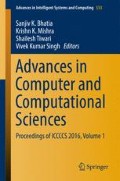Abstract
Each input object in multiple instance learning (MIL) is represented by a set of instances, referred to as ‘bag.’ Therefore, in MIL, class labels are associated with each bag instead of individual instance. This study proposes a classifier for multiple instance learning based on Twin Support Vector Machine, termed as MIL-TWSVM. The proposed approach is trained at bag level, where each bag is represented by a vector of its dissimilarities to other bags in the training set. A comparative analysis of MIL-TWSVM approach is performed with the instance-level and noisy-or (NOR) learning approaches based on TWSVM. The performance of the proposed MIL-TWSVM approach has also been compared with several existing approaches of multiple instance learning. The experiments on eight multiple instance benchmark datasets have shown the superiority of the proposed approach. The significance of experimental results has been tested via statistical analysis conducted by using Friedman’s statistic and Nemenyi post hoc tests.
Access this chapter
Tax calculation will be finalised at checkout
Purchases are for personal use only
References
Dietterich, T. G., Lathrop, R. H., and Lozano-Pérez, T. Solving the multiple instance problem with axis-parallel rectangles. Artificial intelligence, Vol. 89, no. 1, 1997, pp. 31–71.
Cheplygina, V., Tax, D. M., and Loog, M. Multiple instance learning with bag dissimilarities. Pattern Recognition, Vol. 48, no. 1, 2015, pp. 264–275.
Maron, O., and Lozano-Pérez, T. A framework for multiple-instance learning. Advances in neural information processing systems, Vol. 10, 1998, pp. 570–576.
Tax, D. M., Loog, M., Duin, R. P., Cheplygina, V., and Lee, W. J. Bag dissimilarities for multiple instance learning. In Similarity-Based Pattern Recognition, Vol. 7005, 2011, pp. 222–234.
Foulds, J., and Frank, E. A review of multi-instance learning assumptions. The Knowledge Engineering Review, Vol. 25, no. 01, 2010, pp. 1–25.
Chen, Y., Bi, J., and Wang, J. Z. MILES: Multiple-instance learning via embedded instance selection. IEEE Transactions on Pattern Analysis and Machine Intelligence, Vol. 28, no. 12, 2006, pp. 1931–1947.
Ramon J., De Raedt L., Multi instance neural networks, In Proceedings of the ICML-2000 Workshop on Attribute-Value and Relational Learning, 2000, pp. 53–60.
Wang, H., Nie, F., and Huang, H. Learning Instance Specific Distance for Multi-Instance Classification. In 25th AAAI Conference on Artificial Intelligence, 2011, pp. 507–512.
Zhang, Q., and Goldman, S. A. EM-DD: An improved multiple-instance learning technique. In Advances in neural information processing systems, Vol. 14, 2001, pp. 1073–1080.
Wang, J., and Zucker, J. D. Solving multiple-instance problem: A lazy learning approach. In Proceedings of the 17th International Conference on Machine Learning, San Francisco, 2000, pp. 1119–1125.
Andrews, S., Tsochantaridis, I., and Hofmann, T. Support vector machines for multiple-instance learning. In Advances in neural information processing systems, Vol. 15, 2003, pp. 561–568.
P. A. Viola, J. C. Platt, and C. Zhang, Multiple Instance boosting for object detection. In Advances in neural information processing systems (NIPS), Vol. 18, 2006, pp. 1419–1426.
Zhou, Z. H., and Zhang, M. L. Neural networks for multi-instance learning. In Proceedings of the International Conference on Intelligent Information Technology, Beijing, China, 2002, pp. 455–459.
Xu, X., and Frank, E., Logistic regression and boosting for labeled bags of instances. In Advances in knowledge discovery and data mining, Springer Berlin Heidelberg, 2004, pp. 272–281.
Jayadeva, Khemchandani, R., and Chandra, S. Twin support vector machines for pattern classification. IEEE Transactions on Pattern Analysis and Machine Intelligence, Vol. 29, no. 5, 2007, pp. 905–910.
Tomar, D., and Agarwal, S. Twin support vector machine: a review from 2007 to 2014. Egyptian Informatics Journal, Vol. 16, no. 1, 2015, pp. 55–69.
Shao, Y. H., Yang Z. X., Wang X. B. and Deng N. Y. Deng. Multiple instance twin support vector machines. Lect Note Oper Res, Vol. 12, 2010, pp. 433–442.
multi-instance dataset, http://sci2s.ugr.es/keel/. Accessed on May 2015.
Dong, L. A comparison of multi-instance learning algorithms (Doctoral dissertation, The University of Waikato), 2006.
Demšar, J. Statistical comparisons of classifiers over multiple data sets. The Journal of Machine Learning Research, Vol. 7, 2006, pp. 1–30.
Nemenyi, P. Distribution-free multiple comparisons. Ph.D. Thesis. Princeton University, 1963.
Author information
Authors and Affiliations
Corresponding author
Editor information
Editors and Affiliations
Rights and permissions
Copyright information
© 2017 Springer Nature Singapore Pte Ltd.
About this paper
Cite this paper
Tomar, D., Agarwal, S. (2017). Multiple Instance Learning Based on Twin Support Vector Machine. In: Bhatia, S., Mishra, K., Tiwari, S., Singh, V. (eds) Advances in Computer and Computational Sciences. Advances in Intelligent Systems and Computing, vol 553. Springer, Singapore. https://doi.org/10.1007/978-981-10-3770-2_46
Download citation
DOI: https://doi.org/10.1007/978-981-10-3770-2_46
Published:
Publisher Name: Springer, Singapore
Print ISBN: 978-981-10-3769-6
Online ISBN: 978-981-10-3770-2
eBook Packages: EngineeringEngineering (R0)

